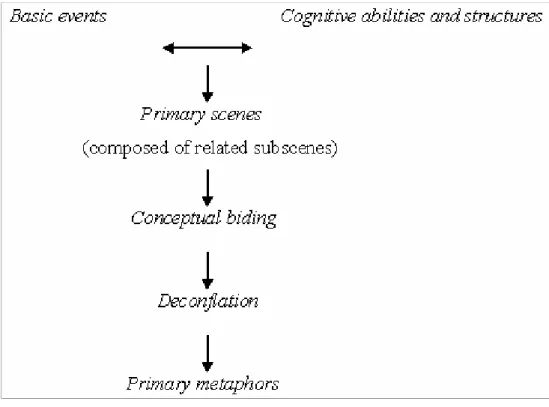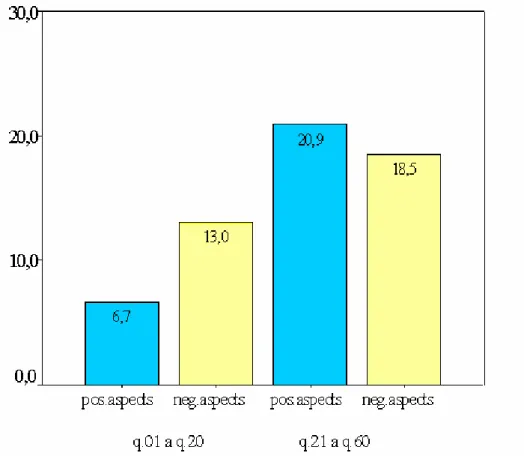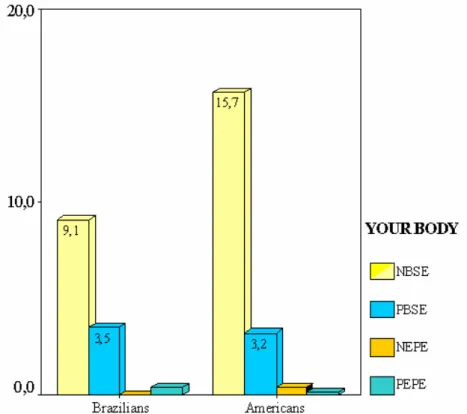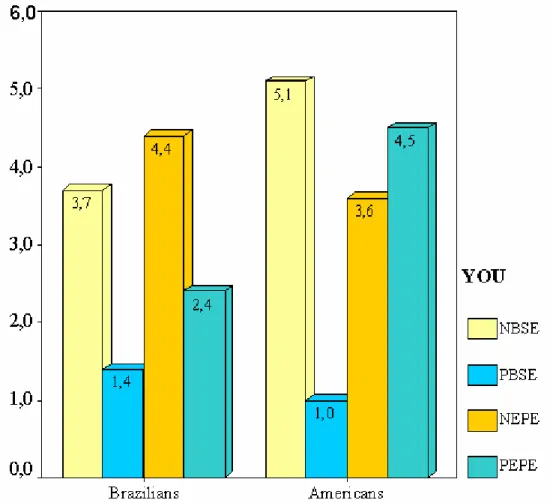A PSYCHOLINGUISTICS ANALYSIS OF THE
METAPHOR “DIFFICULTIES ARE WEIGHTS”
*Ana Cristina Pelosi Silva de Macedo*
Abstract: Partial findings of an on-going research concerned with obtaining a deeper understanding of the mental scenes construed for the DIFFICULTIES ARE BURDENS metaphor are presented. In order to do so, two experiments were run with forty participants, students of the University of California, at Santa Cruz, U. S. A. and Universidade Federal do Ceara, Brazil, involving a word-choice task and a description task, respectively. Both experiments were aimed at obtaining a better knowledge of people´s intuitions as regards their perceptions of weight. Analyses results suggest that, contrary to primary metaphor hypothesis, socio-cultural factors do play a role in the composition of scenes people have internalized for the metaphor´s source domain.
Keywords: primary metaphor; domains correlation; physical experience; social-cultural context.
1 INTRODUCTION
This paper presents some partial findings of two of a subset of five psycholinguistics experiments devised to test the psychological reality of the metaphor DIFFICULTIES ARE WEIGHTS suggested as a primary one by Grady (1997). In order to do so we experimentally test people’s intuitions as regards their perception of weight, the source domain of the metaphor, by verifying if there is a correlation between bodily aspects and psychological/emotional aspects of experiences with weights.
In the next sections, we provide the theoretical basis for the research by exposing the main points pertaining to Primary Metaphor
* Professora da Universidade Federal do Ceará. Doutora em Lingüística e Psicologia. E-mail:
Hypothesis (PMH) as proposed by Joseph Grady, (1997) and Christopher Johnson (1997), the hypotheses which motivated the experiments and the methodological procedure utilized to test the hypothesis. We also discuss the results of statistical analyses performed on the data gathered from two experiments run with 20 Brazilian Portuguese native speakers and 20 American English native speakers involving a word-choice task and a small description task pertaining to experiences with weights.
2 PRIMARY METAPHOR HYPOTHESIS
During the late nineties, Conceptual Metaphor Theory (CMT) in Lakoff and Johnson’s terms, has undergone some significant developments. This was in part due to the advancements introduced to the theory by what has been come to be known as Primary Metaphor Hypothesis proposed by scholars such as Joseph Grady and Christopher Johnson. In positing the existence of a more basic (primary) type of metaphor, supposedly, universal since it would not be subject to cultural constraints, Grady (1997), is specifically interested in explaining some controversial points of the traditional view adopted by CMT such as the circularity present in metaphor identification, the lack of experiential basis between some source and target domains, and the poverty of some mappings. Another important contribution brought about by PMH is the fact that it opens possibilities of falsifying the theory by empirical testing of the hypothesis.
the child repeatedly experiences as he/she is held in someone’s arms. Thus, the subjective experience of feeling affection would be positively correlated with the sensory experience of feeling warmth.
During what Johnson (1997) terms conflation period, authomatic associations between domains (perceptual/conceptual) are formed. The domains, in this phase, are categorized as a non-differentiated whole. Somewhere along the course of cognitive development, during decomflation (or differentiation) period, the child will be able to separate the two domains (affection and warmth), but the associations between domains persist and form metaphorical mappings mechanisms which will allow the child, later on in life, to conceptualize affection in terms of warmth, in expressions such as, “a warm smile” or a “a cold person”, for instance. Furthermore, expressions such as “I’m feeling overloaded” or “he’s weighed down with many problems” would reflect the existence of a metaphorical mapping between subjective experiences relative to the difficulty experienced in life and the difficulty experienced perceptually as one tries to lift and/or carry heavy objects. Such association established along cognitive development, results, as PMH explains it, from numerous recurrent and co-occurent experiences in which weights and difficulties are correlated. This, as the theory has it, leads to the conceptualization of difficulties in terms of weights.
Primary metaphor is, under this view, inevitable, acquired automatically and unconsciously via normal neural learning processing. Every time a subjective experiential domain or judgement is co-activated regularly with a sensory-motor domain, permanent neural connections are formed via changes in synaptic weights. In order words, synaptic weights increase until permanent connections are established. From Johnson’s perspective, primary metaphors are neural connections that have learned by co-activation. From a conceptual perspective, according to Grady’s proposal, they are cross-domain mappings, one of a perceptual nature (source) and another of a conceptual nature (cognitive response) which preserve inferences from one domain to the other and some times, the lexical representation.
constitutes an atomic component of the molecular structure of complex (or compound) metaphors (i.e. metaphors constructed from agglomerations of two or more primary ones). Primary metaphors, thus, do not depend on cultural specificities and their instantiations relate to independent linguistic evidences, which are not related to any compound metaphors.
The way the various languages combine primary metaphors can however, vary resulting in several translinguistic differences whereas primary metaphors tend to uniformization since they are based on human universal experiences (LIMA, 2006, p. 23).
Based on postulates by Lakoff and Johnson (1980), Grady (1997) proposes a generation metaphor model as shown in the Figure 1.
Figure 1 - Grady’s model of metaphor generation (Adapted from GRADY, 1997, p. 20).
basic events would be specific interactions with the world, which occur in specific times and places in varied contexts. For example, we frequently lift up objects, bend our knees, perceive similarities among objects, move from place to place, gather visual information about a given scene etc. However, as Grady (1997) highlights, not all such embodied experiences would be important for the generation of primary metaphors. Only those actions (basic events) linked to the fulfillment of objectives and the satisfaction of desires are part of the so called primary scenes, which are central for primary metaphor generation. Actions such as frequently seeing a given color or cracking one’s fingers would have no significance in primary scenes composition since they are not geared towards the accomplishment of any particular aims. On the other hand, actions such as lifting or moving heavy objects would be significant actions in our goal-oriented interactions with the environment. In this case, a perceptual experience (the weight sensation) correlates with a subjective experience (the discomfort and/or difficulty associated with the action).
We can thus conclude that for Grady, not all events would be termed basic. Basic events are only those which pertain to simple real time experiences, are goal oriented, recurrent, happen in various contexts, and relate in certain ways to our interactions with the world (cf.: GRADY, 1997, p. 20).
Due to our genetic make-up we have the capacity to perceive and analyze what is around us. We can also respond to our perceptual experiences and make judgements regarding the world and our experiences in it. Because of accumulated subjective experiences from basic events and our ability to selectively focus on significant aspects of such experiences, a third element comes into play. These are what Grady terms primary scenes.
These are universal, since they relate to human experience in general and are defined by man’s as goal-oriented interactive cognitive abilities. The various experiential dimensions (i.e. intimacy, proximity, heat, swallow, accept etc), which compose primary scenes, are called subscenes (cf.: GRADY, 1997, p. 23-24).
Once strong correlations are established between source and target domains, conceptual biding takes place associating one concept to the other. While conflation between domains occurs in a more or less high level of processing, deconflation happens during concept manipulation in a lower level of processing.
Source concepts of primary metaphors involve some type of content linked to perceptions or sensations. Mental representations of perceptions of any embodied experience are to be understood as images of various natures (kinesthetic, tactile, auditory, olfative etc). Source concepts thus are characterized for having image content.
Primary target concepts, on the other hand, do not possess image content and do not constitute direct perceptions of experiences. They are responses to operations or functions of such experiences. They are therefore, results of very basic cognitive operations to which we may not have direct access, but that can inform and motivate our actions (GRADY, 1997, p. 26, 135). Such concepts, far from being more abstract or elaborate, as traditional Conceptual Metaphor Theory has it, are found in an even lower level of cognitive processing than source domain concepts. They constitute cognitive responses to sensory inputs of various kinds (i.e. judgement and analysis of individual stimuli and relations among them). Thus, target concepts result from operations over perception of sensory-motor stimuli which possess image schematic structures (source concepts).
3 OBJECTIVES, HYPOTHESES AND EXPERIMENT DESCRIPTIONS
The main objective of the research is to understand more clearly the psychological nature of the supposed primary scenes of the metaphor DIFFICULTIES ARE WEIGHTS, by experimentally testing people’s intuitions as regards their perception of weight (source domain). Secondary objectives are to verify statistically if there is a positive correlation between bodily aspects and psychological/emotional aspects of experiences with weights and to analyse qualitatively participants’ written descriptions of their weight related experiences. Here we discuss only the statistical results of the two first experiments which involved a word-choice task and a briefdescription of experiences with weights run with twenty American English native speakers and twenty Brazilian Portuguese native speakers.
The first experiment, composed of sixty questions where physical symptoms and emotional (psychological) aspects of experiences with weights were presented in a word choice task, aimed at verifying, statistically, the frequency of occurrence of words chosen to describe such experiences. It was hypothesized that due to the common nature of people’s bodies and culturally shared beliefs, there would be high agreement in choosing descriptive words or phrases given as options to describe experiences with weights in a word choice questionnaire.
effect of experiences with weights over the body or self would give rise to a positive correlation (i.e. in describing the effects of dealing with big weights, participants would make up descriptions which would highlight the difficulty of such experiences).
For both experiments, we also assumed that if primary metaphor hypothesis of a positive correlation between perceptual experiences and cognitive responses to such experiences was right, there would be significant correlations between actions involving weights and people subjective responses to them no matter whether physical symptoms or emotional (psychological) aspects were at stake.
4 PROCEDURE FOR EXPERIMENTAL MATERIAL CONSTRUCTION
Based on the frequency of occurrence of words produced by 42 Brazilian Portuguese native speakers, students of the Federal University of Ceara, who took part in a pilot study in which they had to produce words that, according to them were related to the source domain (weight) of the metaphor, five psycholinguistic experiments aimed at verifying if there is a correlation between the target and source domains of the metaphor were constructed. This paper reports on results from the first two of these five experiments.
4.1 Participants
4.2 Analysis procedure and results
In order to make possible the statistical treatment of the data, the main categories of bodily symptoms/effects and emotional/ psychological effects of experiences with weights were sub-categorized as follows.
For experiment one:
- Questions 1-20: bodily symptoms/effects of activities with weights (i.e. questions related to physical experiences with weights. Ex.: Does your body feel pain or no pain when lifting/carrying a heavy weight?);
- Questions 21 – 60: psychological/emotional effects of activities with weights (i.e. questions related to emotional activities involving weights. Ex.: Does holding up a heavy weight make you feel like laughing or crying?).
For experiment two: Subjective descriptions had to be provided to questions grouped into four categories:
- C1: your body (1-7, 19 and 21. Ex.: You are carrying a heavy weight on your shoulders. Describe how your body feels);
- C2: you (8-14. Ex.: You are pushing a heavy weight along rough ground. Describe how you feel);
- C3: the other person’s body (15 and 20. Ex.: You give someone a heavy weight to carry. Describe how you think
his/her body feels);
- C4: each person’s body (6-18. Ex.: You gradually transfer a heavy weight you are holding up onto another person’s shoulders? Describe how your body and the other person’s
body feel. (Change of state on each participants’ bodies)).
Each of these categories was subdivided into positive/negative bodily symptoms/effects (PBSE/NBSE) and positive/negative emotional/psychological effects (PEPE/NEPE).
symptoms/effects - PBSE/ NBSE and the positive/negative emotional/ psychological effects - PEPE/NEPE), the t-test, a parametrical text of significance, was applied to the data.
For both Americans and Brazilian participants, the results for experiment 1 [Fig. 2], graphically shown below, demonstrate that while there is a significant difference (Americans: t=-3,713; p<0,05 and Brazilians: t=-3,639; p<0,05) between weights and difficulties for bodily aspects of experiences with weights (q.01 to q.20), indicating a relation between weights and difficulties when the body is at focus, the same cannot be said as regards to emotional/psychological aspects of experiences with weights (q.21 to q.60), since the mean averages for positive and negative aspects (20,9 and 18,5) from word frequency produced to describe experiences with weights do not display a significant difference.
The second experiment tested positive and negative symptoms or effects relating to the body, self, the other person’s body or self were. The results of the statistical analyses performed on the data for the various categories (C1 to C4) [Fig. 3] suggest the same pattern which had already been made evident in the case of experiment 1.
For C1, the statistical analysis reveals that negative physical aspects (NBSE) were more frequent in experiences with weights. Comparing Americans and Brazilians in this category, it is noted that the two groups differ only in relation to the mean frequency of use of designatory terms to describe negative physical effects of experiences with weights. As shown in Figure 3 below, Americans relate more negative physical aspects than Brazilians do (t=-2,72; p<0,05). The results also show that while effects of weights over the body are indeed viewed as difficulties by both groups of participants, the same cannot be said when emotional/psychological effects are considered [see columns for NEPE and PEPE categories in the Figure 3].
Figure 3 - Mean frequencies of words employed in small descriptions about experiences with weights by Americans and Brazilians for the body
Category C2 focused on bodily and emotional experiences related to the self (how your body/you feel). As regards the results of the statistical analysis for this category it can be said that negative bodily experiences (NBSE) and emotional ones (NEPE) are not statistically different in the overall sample. However, Brazilians tend to relate more negative aspects to their psychological/emotional experiences with weights than Americans do. This trend is reversed when positive emotional/psychological aspects are compared (t=-2,137; p<0,05), as shown in Figure 4.
Figure 4 - Mean frequencies of words employed in small descriptions about experiences with weights by Americans and
The analysis of the C3 category (the other person’s body) reveals that positive physical experiences were more frequently for Brazilians as compared to negative ones (NBSE). For Americans, both positive and negative physical aspects of bodily experiences with weights do not differ. Americans, in contrast with Brazilians, also relate more negative physical aspects to weight experiences involving the other person’s body (t=-2,38; p<0,05), as shown in Figure 5. For each participant’s bodies category (C4), no statistical difference among variables was detected [see Fig. 6].
Figure 5 - Mean frequencies of words employed in small descriptions about experiences with weights by Americans and
Figure 6 - Mean frequencies of words employed in small descriptions about experiences with weights by Americans and
Brazilians for body’s category.
5 CONCLUSION
conceptual domains, subjective experiences construed along one’s cognitive development in a social-cultural situated context, also appear to play a significant role in the metaphor’s constitution. It is hoped that the qualitative analysis still to be performed on data gathered for experiment 02 as well as the application of the remaining experiments will shed more light on the conclusions reached so far.
REFERENCES
GRADY, J. Foundations of meaning: primary metaphors and primary scenes. PhD dissertation – University of California, Berkeley, 1997.
JOHNSON, C. Metaphor vs. conflation in the acquisition of polysemy: the case of SEE. In: HIRAGA, M.K.; SINHA, C.; WILCOX, S. (Eds.). Cultural,
typological and psychological issues in Cognitive Linguistics. Amsterdam: John Benjamins, 1997.
LAKOFF, G.; JOHNSON, M. Metaphors we live by. Chicago: Chicago University Press, 1980.
LIMA, P. L. C. About primary metaphor. DELTA - Documentação de Estudos em Lingüística Teórica e Aplicada, São Paulo, v. 22, n. Especial, p. 109-122, 2006.
Recebido em 03/05/07. Aprovado em 18/09/07.
Título: Uma análise psicolingüística da metáfora “dificuldades são pesos”
Autor: Ana Cristina Pelosi Silva de Macedo
Resumo: Resultados parciais de uma pesquisa em andamento cujo objetivo é a
obtenção de um entendimento mais aprofundado das cenas mentais relativas à metáfora, são apresentados. Para tanto, dois experimentos foram aplicados a quarenta sujeitos, alunos da Universidade da Califórnia em Santa Cruz, E. U. A. e Universidade Federal do Ceará, Brasil, envolvendo tarefas de escolha de palavras e de descrição, respectivamente. Os experimentos objetivaram a apreensão de um melhor conhecimento sobre as intuições das pessoas a respeito de suas percepções sobre peso. Resultados das análises sugerem que, contrário ao que apregoa a hipótese da metáfora primária, fatores de ordem sócio-cultural influenciam a composição das cenas que as pessoas internalizaram para o domínio fonte da metáfora.
Palavras-chave: metáfora primária; correlação de contextos; experiência física;
Titre: Une analyse psycholinguistique de la métaphore “difficultés sont poids”
Auteur: Ana Cristina Pelosi Silva de Macedo
Résumé: Des résultats partiels d’une recherche qui est en marche dont l’objectif est l’acquisition d’un entendement plus profond des scènes mentales relatives à la métaphore « difficultés sont des poids», sont présentés. Pour autant, deux essais furent employés par quarante sujets, élèves de l’Université Fédérale de Ceará, Brésil, comprenant des tâches dans le choix de mots et de description, respectivement. Les essais ont eu l’objectif de l’appréhension d’une meilleure connaissance sur les institutions des personnes à propos de leurs perceptions sur le poids. Les résultats de l’analyse suggèrent que, contrairement à ce qu’annonce l’hypothèse de la métaphore primaire, des facteurs d’ordre socioculturel influencent la composition des scènes que ces personnes ont incorporé dans le domaine source de la métaphore.
Mots-clés: métaphore primaire; corrélation de contextes; expérience physique;
contexte socio-cultural.
Título: Un análisis psico-lingüístico de las dificultades de las metáforas como pesos
Autor: Ana Cristina Pelosi Silva de Macedo
Resumen: Resultados parciales de una pesquisa en funcionamiento cuyo objetivo es la
obtención de un entendimiento más profundo de las escenas mentales relativas a la metáfora “dificultades son pesos”, son presentados. Para eso, dos experimentos fueron aplicados a cuarenta sujetos, alumnos de la Universidad de California en Santa Cruz, E.U.A. y de la Universidad Federal de Ceará, Brasil, envolviendo tareas de elección de palabras y de descripción, respectivamente. Los experimentos objetivaron la obtención de un mejor conocimiento sobre las intuiciones de las personas a respecto de sus percepciones sobre peso. Los resultados de los análisis sugieren que, contra lo que se dice la hipótesis de la metáfora primaria, factores de orden socio-cultural influencian la composición de las escenas que las personas internalizaron para el dominio fuente de la metáfora.
Palabras-clave: metáfora primaria; correlación de contextos; experiencia física;





